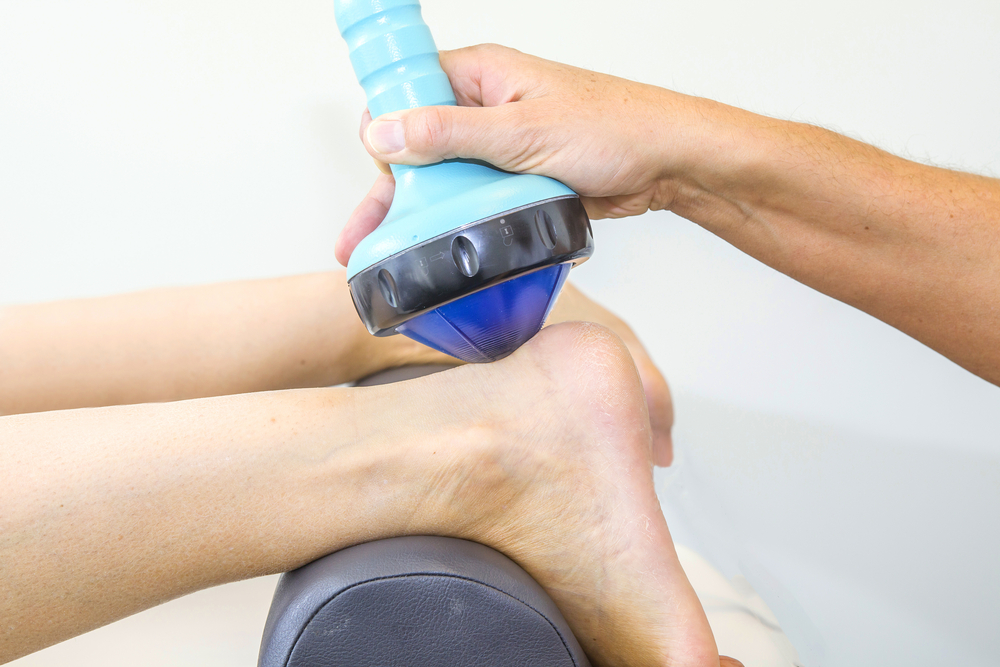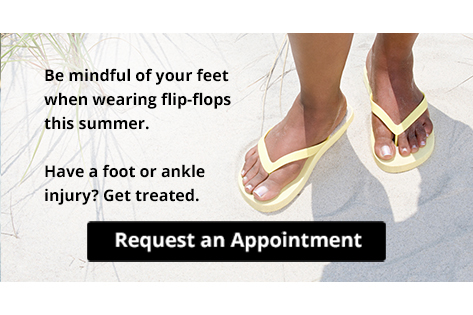Items filtered by date: August 2021
What Does a Bunion Look Like?
 A bunion is a bony bump located on the outside of the big toe. The bump may be swollen, red, and irritated due to friction as it rubs against your shoes. Bunions deform the feet, making the first metatarsal foot bone stick out and causing the big toe to point towards the other toes. Thick, hardened skin or calluses often form on the second toe and underneath the big toe. A bunion can also make it difficult to find comfortable shoes, as they change the structure of the feet. They can also cause pain and discomfort while walking or standing. Bunions tend to get worse without treatment, so if you have bunions, it is suggested that you seek the care of a podiatrist to stop or slow their progression and get the right treatment for you.
A bunion is a bony bump located on the outside of the big toe. The bump may be swollen, red, and irritated due to friction as it rubs against your shoes. Bunions deform the feet, making the first metatarsal foot bone stick out and causing the big toe to point towards the other toes. Thick, hardened skin or calluses often form on the second toe and underneath the big toe. A bunion can also make it difficult to find comfortable shoes, as they change the structure of the feet. They can also cause pain and discomfort while walking or standing. Bunions tend to get worse without treatment, so if you have bunions, it is suggested that you seek the care of a podiatrist to stop or slow their progression and get the right treatment for you.
If you are suffering from bunions, contact James Pak, DPM of California. Our doctor can provide the care you need to keep you pain-free and on your feet.
What Is a Bunion?
A bunion is formed of swollen tissue or an enlargement of boney growth, usually located at the base joint of the toe that connects to the foot. The swelling occurs due to the bones in the big toe shifting inward, which impacts the other toes of the foot. This causes the area around the base of the big toe to become inflamed and painful.
Why Do Bunions Form?
Genetics – Susceptibility to bunions are often hereditary
Stress on the feet – Poorly fitted and uncomfortable footwear that places stress on feet, such as heels, can worsen existing bunions
How Are Bunions Diagnosed?
Doctors often perform two tests – blood tests and x-rays – when trying to diagnose bunions, especially in the early stages of development. Blood tests help determine if the foot pain is being caused by something else, such as arthritis, while x-rays provide a clear picture of your bone structure to your doctor.
How Are Bunions Treated?
- Refrain from wearing heels or similar shoes that cause discomfort
- Select wider shoes that can provide more comfort and reduce pain
- Anti-inflammatory and pain management drugs
- Orthotics or foot inserts
- Surgery
If you have any questions, please feel free to contact our office located in Anaheim, CA . We offer the newest diagnostic and treatment technologies for all your foot care needs.
Who Can Achilles Tendonitis Affect?
The Achilles tendon connects the heel with two large muscles in the calf that allows the foot to push off. This pushing off motion is necessary for walking, running, and jumping. Achilles tendonitis is a painful inflammation of this tendon where it connects at the heel. In younger people, Achilles tendonitis may develop from overuse. This may be from increasing the intensity of an activity suddenly, running too often on hard surfaces for longer distances, jumping excessively, or wearing shoes without proper support. It may also occur if the foot turns in or out abruptly. In older and middle-aged adults, Achilles tendonitis may be caused by arthritis, bone spurs, and other conditions that aggravate or put excess tension on the tendon. If you have pain in your heel a podiatrist can examine you to determine the origin and develop an effective treatment plan that is specific for you.
Achilles tendon injuries need immediate attention to avoid future complications. If you have any concerns, contact James Pak, DPM of California. Our doctor can provide the care you need to keep you pain-free and on your feet.
What Is the Achilles Tendon?
The Achilles tendon is a tendon that connects the lower leg muscles and calf to the heel of the foot. It is the strongest tendon in the human body and is essential for making movement possible. Because this tendon is such an integral part of the body, any injuries to it can create immense difficulties and should immediately be presented to a doctor.
What Are the Symptoms of an Achilles Tendon Injury?
There are various types of injuries that can affect the Achilles tendon. The two most common injuries are Achilles tendinitis and ruptures of the tendon.
Achilles Tendinitis Symptoms
- Inflammation
- Dull to severe pain
- Increased blood flow to the tendon
- Thickening of the tendon
Rupture Symptoms
- Extreme pain and swelling in the foot
- Total immobility
Treatment and Prevention
Achilles tendon injuries are diagnosed by a thorough physical evaluation, which can include an MRI. Treatment involves rest, physical therapy, and in some cases, surgery. However, various preventative measures can be taken to avoid these injuries, such as:
- Thorough stretching of the tendon before and after exercise
- Strengthening exercises like calf raises, squats, leg curls, leg extensions, leg raises, lunges, and leg presses
If you have any questions please feel free to contact our office located in Anaheim, CA . We offer the newest diagnostic tools and technology to treat your foot and ankle needs.
The Many Causes of Heel Pain
 Heel pain can have a variety of causes, but the most common cause of it is plantar fasciitis. This occurs when the long band of tissue on the sole of the foot becomes inflamed. Women late in their pregnancy and people who waitress or work on their feet all day may be more at risk for developing this type of heel pain. Other causes of heel pain can include: a small crack in the heel bone, compressed nerves, worn down heel pads, nerve damage, thickened tissue surrounding a nerve, inflammation of the tendon that connects the heel bone with the calf muscles, plantar warts, and abnormalities in the bone which can causes inflammation of the bursa sac. There may also be injury to the tunnel between the heel and talus bones known as Sinus Tarsi Syndrome. If you are struggling with any type of pain in your heel it is suggested that you schedule an appointment with a podiatrist for an accurate diagnosis and proper treatment.
Heel pain can have a variety of causes, but the most common cause of it is plantar fasciitis. This occurs when the long band of tissue on the sole of the foot becomes inflamed. Women late in their pregnancy and people who waitress or work on their feet all day may be more at risk for developing this type of heel pain. Other causes of heel pain can include: a small crack in the heel bone, compressed nerves, worn down heel pads, nerve damage, thickened tissue surrounding a nerve, inflammation of the tendon that connects the heel bone with the calf muscles, plantar warts, and abnormalities in the bone which can causes inflammation of the bursa sac. There may also be injury to the tunnel between the heel and talus bones known as Sinus Tarsi Syndrome. If you are struggling with any type of pain in your heel it is suggested that you schedule an appointment with a podiatrist for an accurate diagnosis and proper treatment.
Many people suffer from bouts of heel pain. For more information, contact James Pak, DPM of California. Our doctor can provide the care you need to keep you pain-free and on your feet.
Causes of Heel Pain
Heel pain is often associated with plantar fasciitis. The plantar fascia is a band of tissues that extends along the bottom of the foot. A rip or tear in this ligament can cause inflammation of the tissue.
Achilles tendonitis is another cause of heel pain. Inflammation of the Achilles tendon will cause pain from fractures and muscle tearing. Lack of flexibility is also another symptom.
Heel spurs are another cause of pain. When the tissues of the plantar fascia undergo a great deal of stress, it can lead to ligament separation from the heel bone, causing heel spurs.
Why Might Heel Pain Occur?
- Wearing ill-fitting shoes
- Wearing non-supportive shoes
- Weight change
- Excessive running
Treatments
Heel pain should be treated as soon as possible for immediate results. Keeping your feet in a stress-free environment will help. If you suffer from Achilles tendonitis or plantar fasciitis, applying ice will reduce the swelling. Stretching before an exercise like running will help the muscles. Using all these tips will help make heel pain a condition of the past.
If you have any questions please contact our office located in Anaheim, CA . We offer the newest diagnostic and treatment technologies for all your foot and ankle needs.
Is Shockwave Therapy Painful?
Shockwave therapy is a potential treatment option for various foot and ankle conditions, particularly chronic plantar fasciitis, which causes pain in the heel and arch. Shockwave therapy is a non-invasive treatment that uses pressurized air or electromagnetic pulses to stimulate the body’s natural healing processes in the affected area. There are two main types of shockwave treatments - low energy and high energy. Low energy shockwave treatments are typically painless or mildly painful. High energy shockwave treatments can be painful and sometimes require anesthesia. If you have chronic plantar fasciitis and conservative treatments have not helped, shockwave therapy may be another treatment option for you to consider. To learn more about this and other treatments for plantar fasciitis, please consult with a podiatrist.
Shockwave therapy is a treatment commonly used to treat various injuries and conditions, particularly plantar fasciitis in the feet. To learn more, consult with James Pak, DPM from California. Our doctor can provide the care you need to keep you pain-free and on your feet.
Shockwave Therapy
Shockwave therapy is a new treatment option designed to treat bone conditions such as tennis elbow, shoulder pain, and others. Shockwave therapy uses high intensity sound waves that are directed to the affected tissues of the body with pinpoint accuracy. The effects are very beneficial, leading to a production of collagen fibers, eliminating inflammation.
Who Benefits from Shockwave?
Shockwave is recommended for patients suffering from heel pain and associated problems. Heel pain is a common condition which can be caused by obesity, overexertion, and spending a substantial amount of time on hard floors with your feet exposed and unsupported.
Fast and Easy
The therapy is actually a simple process that can leave patients feeling better the very next day. Shockwave therapy is not as dramatic as it sounds. It enables more blood flow to effected areas, addressing the source of the problem and allowing treatment to last for a long time.
Treatment & Recovery Time
Shockwave treatment will enable your feet to recover quickly. This is especially important since surgery is not required. It is cost effective and does not require the use of anesthesia. This treatment is a better option to surgery, since it is proven safe.
If you have any questions, please feel free to contact our office located in Anaheim, CA . We offer the newest diagnostic and treatment technologies for all your foot and ankle needs.
Be Mindful Of Your Feet While Wearing Flip-Flops This Summer
Healthy Foot Tips for Hiking
 Whether you are heading out for a quick day hike or plan on camping and hiking for a few days, there are measures that can be implemented to ensure that your feet are up to the task. One of the most common conditions that can wreak havoc on the feet during a hike is developing an ingrown toenail. Having long toenails can cause discomfort, but cutting the nails too short and having them grow into the skin can be excruciating. The best advice to help prevent ingrown toenails is to cut the toenails straight across and not too short before you even leave for a hike. The next step is to make sure that your shoes or hiking boots fit properly by ensuring the back of the heel sits tight to the back of the shoe, but the toes can still wiggle. Once hiking, any discomfort to the feet should be addressed right away. This can be accomplished by changing socks and bandaging any areas that may be forming blisters. After the hike it is important not to pop any blisters on the feet in order to reduce the risk of infection. If you have questions about keeping your feet healthy during your next hike or camping trip, it is suggested that you consult with a podiatrist.
Whether you are heading out for a quick day hike or plan on camping and hiking for a few days, there are measures that can be implemented to ensure that your feet are up to the task. One of the most common conditions that can wreak havoc on the feet during a hike is developing an ingrown toenail. Having long toenails can cause discomfort, but cutting the nails too short and having them grow into the skin can be excruciating. The best advice to help prevent ingrown toenails is to cut the toenails straight across and not too short before you even leave for a hike. The next step is to make sure that your shoes or hiking boots fit properly by ensuring the back of the heel sits tight to the back of the shoe, but the toes can still wiggle. Once hiking, any discomfort to the feet should be addressed right away. This can be accomplished by changing socks and bandaging any areas that may be forming blisters. After the hike it is important not to pop any blisters on the feet in order to reduce the risk of infection. If you have questions about keeping your feet healthy during your next hike or camping trip, it is suggested that you consult with a podiatrist.
Everyday foot care is very important to prevent infection and other foot ailments. If you need your feet checked, contact James Pak, DPM from California. Our doctor can provide the care you need to keep you pain-free and on your feet.
Everyday Foot Care
Often, people take care of their bodies, face and hair more so than they do for their feet. But the feet are a very important aspect of our bodies, and one that we should pay more attention to. Without our feet, we would not be able to perform most daily tasks.
It is best to check your feet regularly to make sure there are no new bruises or cuts that you may not have noticed before. For dry feet, moisturizer can easily be a remedy and can be applied as often as necessary to the affected areas. Wearing shoes that fit well can also help you maintain good foot health, as well as making it easier to walk and do daily activities without the stress or pain of ill-fitting shoes, high heels, or even flip flops. Wearing clean socks with closed shoes is important to ensure that sweat and bacteria do not accumulate within the shoe. Clean socks help to prevent Athlete’s foot, fungi problems, bad odors, and can absorb sweat.
If you have any questions please feel free to contact our office located in Anaheim, CA . We offer the newest diagnostic and treatment technologies for all your foot and ankle needs.



